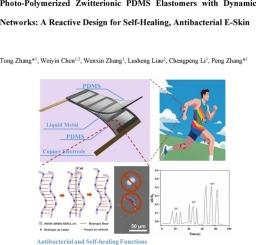Photo-polymerized zwitterionic PDMS elastomers with dynamic networks: A reactive design for self-healing, antibacterial E-skin
IF 5.1
3区 工程技术
Q1 CHEMISTRY, APPLIED
引用次数: 0
Abstract
Flexible electronic skin (E-skin) demands materials with skin-like softness, self-healing capability, and antibacterial properties for long-term wearable applications. Here, we developed a series of self-healing, antibacterial zwitterionic polydimethylsiloxane (PDMS) elastomers via a facile photo-polymerization strategy. The elastomer was synthesized by crosslinking acrylate-terminated PDMS (PDMS-IU-MA) with zwitterionic sulfobetaine methacrylate (SBMA) using reactive hyperbranched polysiloxane (HPBSi) containing methacrylate groups as a multifunctional mediator. The resulting material exhibited remarkable antibacterial effects against E. coli and S. aureus, attributed to the zwitterionic SBMA moieties, while the dynamic hydrogen-bonding network formed by urethane/urea groups enabled self-healing ability. The mechanical properties, self-healing efficiency, and antibacterial performance were systematically tuned by varying the SBMA content. Furthermore, a conductive E-skin capable of precisely monitoring human motion through resistance changes was fabricated by integrating liquid metal (LM) microdroplets into an optimized PDMS matrix. This work provides a scalable strategy to integrate antimicrobial protection, self-healing, and strain sensing into E-skin for next-generation wearable electronics.

具有动态网络的光聚合两性离子PDMS弹性体:一种自愈、抗菌电子皮肤的反应性设计
柔性电子皮肤(E-skin)要求材料具有皮肤般的柔软性、自修复能力和抗菌性能,以实现长期可穿戴应用。在这里,我们开发了一系列自修复,抗菌两性离子聚二甲基硅氧烷(PDMS)弹性体通过一个简单的光聚合策略。以含甲基丙烯酸酯基团的反应性超支化聚硅氧烷(HPBSi)为多功能介质,将端接丙烯酸酯的PDMS (PDMS- u - ma)与两性离子甲基丙烯酸磺基甜菜碱(SBMA)交联合成弹性体。该材料对大肠杆菌和金黄色葡萄球菌具有显著的抗菌作用,这主要归功于两性离子SBMA基团,而由聚氨酯/尿素基团形成的动态氢键网络使其具有自愈能力。通过改变SBMA的含量,系统地调整了材料的力学性能、自愈效率和抗菌性能。此外,通过将液态金属(LM)微滴集成到优化的PDMS矩阵中,制备了一种能够通过电阻变化精确监测人体运动的导电电子皮肤。这项工作提供了一种可扩展的策略,将抗菌保护、自我修复和应变传感集成到下一代可穿戴电子产品的E-skin中。
本文章由计算机程序翻译,如有差异,请以英文原文为准。
求助全文
约1分钟内获得全文
求助全文
来源期刊

Reactive & Functional Polymers
工程技术-高分子科学
CiteScore
8.90
自引率
5.90%
发文量
259
审稿时长
27 days
期刊介绍:
Reactive & Functional Polymers provides a forum to disseminate original ideas, concepts and developments in the science and technology of polymers with functional groups, which impart specific chemical reactivity or physical, chemical, structural, biological, and pharmacological functionality. The scope covers organic polymers, acting for instance as reagents, catalysts, templates, ion-exchangers, selective sorbents, chelating or antimicrobial agents, drug carriers, sensors, membranes, and hydrogels. This also includes reactive cross-linkable prepolymers and high-performance thermosetting polymers, natural or degradable polymers, conducting polymers, and porous polymers.
Original research articles must contain thorough molecular and material characterization data on synthesis of the above polymers in combination with their applications. Applications include but are not limited to catalysis, water or effluent treatment, separations and recovery, electronics and information storage, energy conversion, encapsulation, or adhesion.
 求助内容:
求助内容: 应助结果提醒方式:
应助结果提醒方式:


